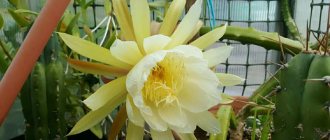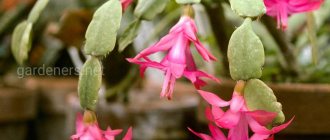Giant Cereus
The world's largest cactus is a relict plant of the Sonoran Desert and is protected by the US authorities. The territory where it grows has been declared a national park. Unauthorized cutting down or damage to saguaros will result in criminal penalties.
Carnegia giant is a unique symbol of the Wild West: it can be seen in Western films and in paintings by American artists. Tourists take picturesque full-length photos against the backdrop of a huge cactus.
Saguaro fruits are edible: they are eaten raw or a starter is prepared from them, which is used to ferment low-alcohol drinks. The resulting product tastes like moonshine and is served at all local holidays. Cactus pulp is used in folk medicine as an external analgesic and a means of relaxation.
Cereus growing straight and upward form tall hedges that perform decorative and protective functions. The strong fibers of cactus wood form a loose layer consisting of winding loops. Cereus wood is used in the construction of bridges, beams, pillars, and thresholds in small houses.
Second place: giant carnegia
Saguaro - this is how the Mexicans call another giant, which is several times larger than the previous one. Carnegia gianta grows in Mexico, as well as in the southern regions of the North American continent. Arriving in the USA in the hope of seeing one of the cacti that looks more like a tree, you should go to Arizona or California.
The height of the giant Carnegia is impressive: the tallest representative of the genus managed to grow up to 18 meters. Of course, the entire “body” of the plant is strewn with needles. But they are not small, like those of other members of the family, but on the contrary - quite long, up to 7 cm in length. True, if we take into account the height of the giant carnegia, we can conclude that everything in this plant is proportional.
For a long time, giant carnegia belonged to the genus of Cereus cacti and was not an independent plant. However, not so long ago, scientists came to the conclusion that Carnegia has characteristic differences that allow it to “disconnect” from the cereus. The most gigantic representative of the cactus species under discussion was found in Arizona. Its height was 17 meters and 65 centimeters.
Carnegie got its name thanks to Andrew Carnegie, a multimillionaire and philanthropist.
Detailed description of appearance
The growing season of a cactus is about 300 years. The plant is a ribbed green column weighing 6-10 tons, 50-65 cm thick and 15-20 m high. A well-developed trunk has 12-24 large sides with gray, brown or black spines. 8-12 branches branch vertically from the trunk.
Saguaros have no leaves. The rudiments of small leaves, similar to irregularly shaped scales, can be seen in the deep grooves of some young plants. The role of leaves responsible for gas exchange is played by green stems. The dense skin has a small number of stomata. Under the skin there are cells containing cell sap. In arid climates it serves as a source of liquid. An adult cereus holds about 2 tons of water inside.
Carnegia gianta has a powerful root system located in the surface layer of the earth. During the rainy season, the roots quickly absorb moisture and transfer it to the plant cells. During drought, the cactus does not evaporate moisture, but firmly retains it inside the stem.
The plant blooms about 30 days a year: from May to June. Flowers appear from buds on the trunk and branches of trees. Peduncles are large, tubular, solitary. They can be painted in different shades: from purple to white.
They are pollinated by insects, bats or small birds. The fruits are large, fleshy berries that are suitable for consumption.
Home cacti
Those same pets that decorate tables and window sills all over the world. They are unpretentious, rarely need watering and do not cause much trouble for owners.
Cereus
These popular cacti stand out in a beautiful, statement candle. At home, Peruvian varieties are usually grown, which reach about 50 cm in height, but sometimes more.
Photo: hausgarten.net
Notocactus
A beautiful spherical or cylindrical cactus with different thicknesses and shapes of stems depending on the variety. Notocactus grows very slowly, so it is suitable for those who do not want to constantly replant.
Photo: flowersbook.ru
Gymnocalycium
A neat spherical cactus, densely covered with large spines. In an apartment it grows up to 30 cm and over time begins to actively bloom. This is a good unpretentious option for beginners!
Photo: roomflower.ru
Chamecereus
A bushy cactus with thin shoots densely covered with spines, it quickly grows in length and breadth. It blooms profusely with large red flowers, and some varieties are good for hanging.
Photo: ronaquirkybirdgardener.blogspot.com
Rebutia
Even adult specimens of rebutia are very tiny - up to 10 cm in diameter, or even up to 5 cm. But their buds are very large and bright, and you can even achieve repeated flowering.
Photo: dailygo.ru
Trichocereus
This type of cereus is distinguished by very fragrant snow-white funnel-shaped flowers. The diameter of the open buds sometimes reaches 20 cm. The shoots are green or yellowish.
Photo: sportobzor.ru
Espostoa
This is a fluffy cactus that is almost completely covered with fine silky hairs. Some varieties are even wrapped in a solid cocoon.
Photo: ogorod-bez-hlopot.ru
Eriosice
A capricious but spectacular cactus with green or grayish stems. They are very ribbed and prickly. As the cactus ages, it blooms with cream, pink or red flowers.
Photo: pinterest.pt
Wilcoxia
A very popular flowering species of cacti, which is abundantly covered with buds throughout the spring. Thin long shoots-twigs, on which large flowers bloom, also look interesting.
Photo: koffkindom.ru
Echinocereus
Echinocereus pleases gardeners with large pink flowers. Comb varieties are very good. In some species, even the spines are pink.
Photo: search.fotki.com
Succulents (85 photos): types, care features
Additional information about the plant
Interesting facts about the cactus:
- The name cereus translated from Latin means “torch”, “candle”, “wax”.
- The giant cereus can tolerate temperatures below 0 °C and snow.
- Scientists suggest that the cactus previously also grew in Africa and East Asia.
- The plant does not bloom in the growing season from 50 to 75 years.
- Representatives of the Hohokam culture endow cereus with the ability to evoke prophetic visions.
- The Tohono O'odham people use cactus spines as sewing needles.
- Small animals like to make their homes in dried cacti: owls, mice, woodpeckers, snakes.
- The saguaro begins to actively grow only after 30 years of life.
The growth rate of a cactus greatly depends on the degree of soil moisture. In the Mexican deserts, giant cereus reaches adult size 2 times slower than, for example, in Arizona.
The history of the origin of large cacti
Fossil remains of the cactus have not yet been found, so it is difficult to accurately say their age and origin. However, there are scientists’ assumptions that these amazing representatives of the flora are about 20 thousand years old. If this is so, then cacti are the youngest plants on Earth.
They came from ordinary plants that are more familiar to us. Cacti acquired their appearance and their amazing resistance to harsh living conditions due to many years of changes and adaptation. When ordinary plants began to experience conditions of moisture deficiency and scorching sunlight, they needed to somehow adapt in order to survive. The leaves turned into thorns, the trunks into a base capable of retaining moisture for a long time.
Thanks to their ability to adapt and survive in difficult conditions, cacti have spread to almost all continents of the globe. For example, in India, Bali, and Australia, prickly pear is widespread. But the homeland of this plant is in a completely different place.
The historical homeland of cacti is arid South America. And their ancestors were moisture-loving vines. Most of them died out in the severe droughts of the deserts, and only a few representatives survived due to the reduction of leaves. Then they began to spread throughout the United States, and from there to other countries. There are especially many in the states of Texas, Arizona and New Mexico. On their territory you can find cacti several hundred years old and of enormous size.
Due to their ease of care and cultivation, unusual appearance and diversity, cacti have become a popular indoor plant. They are often found not only in apartments, but also in offices and workplaces.
Who coined the word CACTUS?
The word “cactus” itself was first introduced into scientific circulation by the Swedish botanist Carl Linnaeus, the creator of the system of flora and fauna. In his “System of Nature” (1735), he identified the genus “cactus”, which included 24 species of plants. Since then, thanks to close attention to these plants, the number of genera and species discovered and described has increased many times over. According to the well-known classification of Backeberg alone, this family consisted of 233 genera, including 2800 species. Currently, there are more than 10,000 species and varieties of cacti. They are very different from each other. Among them there are herbaceous, shrubby, semi-shrub and tree-like species. Their external form is the most bizarre. There are columnar plants, among which the most interesting are Eulichnia, Neoraimondia, Hageocereus, Armatocereus, etc., growing in the coastal deserts of Chile and Peru, and in the mountainous regions of Argentina and Bolivia one can find large columnar Trinchocereus, Helianthocereus, Cleistocactus; spherical: neoporteria, copiapoa, neochilenia, horridocactus, etc.; “white-headed” cacti: haageocereus, espostoa; oreocereus are found in the Mexican mountains: fossulatus, trolls, hendricksenianus, celsianus.
How to grow Carnegia gianta at home
Saguaro cacti grow in arid desert climates, so for them to thrive as an indoor plant, similar conditions must be replicated. Although it grows very slowly, indoors the plant will grow a little faster and reach a height of 30 cm in 10-15 years. In the future, he will need to allocate space in the room. Read on for what you need to know about caring for your Saguaro.
The soil
Saguaro prefers to grow in neutral, loamy, well-drained soil.
Carnegia needs a regular substrate for succulents with a small content of organic matter (peat, humus). For optimal growth, you can also add a layer of pebbles or gravel on top - this will reduce soil moisture levels and stabilize the cactus as it grows.
Pot
Carnegiea have a weak root system, so do not grow them in a container that is too large. A shallow pot with drainage holes will initially be suitable for it. Most likely, it will take a couple of years before there is a need to change the container to a larger size.
Cactus care information
What soil is needed to grow cacti?
How to water cacti correctly to avoid mistakes in care
How to properly use fertilizer for cacti at home
Lighting
Carnegia gianta thrives in full sun, but prolonged periods of bright, hot sun can burn the surface of the trunk. If you are going to grow it in your home, choose a place in front of windows facing west or south. At a young age, Carnegia needs to be provided with more filtered light.
An adult cactus needs more direct sunlight. It is also advisable to move the plant pot outside during the warm summer months.
Temperature and humidity
Saguaro is a heat-loving cactus and does not tolerate cold weather. Frosts down to -5 °C will already be fatal for him. During the dormant period it must be kept at a temperature of at least 8 °C. Also, the indoor air should be dry during the winter months.
During the rest period, high air humidity is not allowed!
Watering
In summer, try to water regularly, but do not over-water. Allow the soil to dry completely before watering again. Carnegia gianta is very sensitive to soil moisture, its delicate root system is especially affected.
Photo of a two-year-old Saguaro
Surface roots die quickly in soil that remains wet for a long time. During the winter, Saguaros should not be watered at all.
Fertilizer
During the growing season, enrich the soil with a fertilizer rich in potassium and phosphorus, but less nitrogen, because it does not promote optimal development of succulent plants, making them too soft.
Transfer
Carnegia gianta has a different root system from other cacti. When it's time to replant your Saguaro, you'll need to trim its taproot.
Photo of Carnegia at age 15
This is not difficult if you are careful when handling the cactus. You may need an assistant for this. The ideal time to transplant Carnegia is morning or evening, when the temperature drops to 16 °C.
- To begin, carefully run a sharp knife along the inside wall of the container to separate the soil mixture from the pot.
- Carefully remove the cactus and trim off any dead parts with a sharp knife or pruning shears. Prune the tap root, leaving small, superficial roots. Before transplanting, you need to let the roots dry for several hours.
- The new container should not be deep but wide enough (larger than the size of the root system). It is advisable to place several stones at the bottom of the container to stabilize the pot in the future.
- Carefully lay the plant down and spread the tender roots throughout the space. Fill with substrate and lightly moisten the soil.
During transplantation, use protective clothing and thick gloves to avoid being pricked by sharp thorns.











